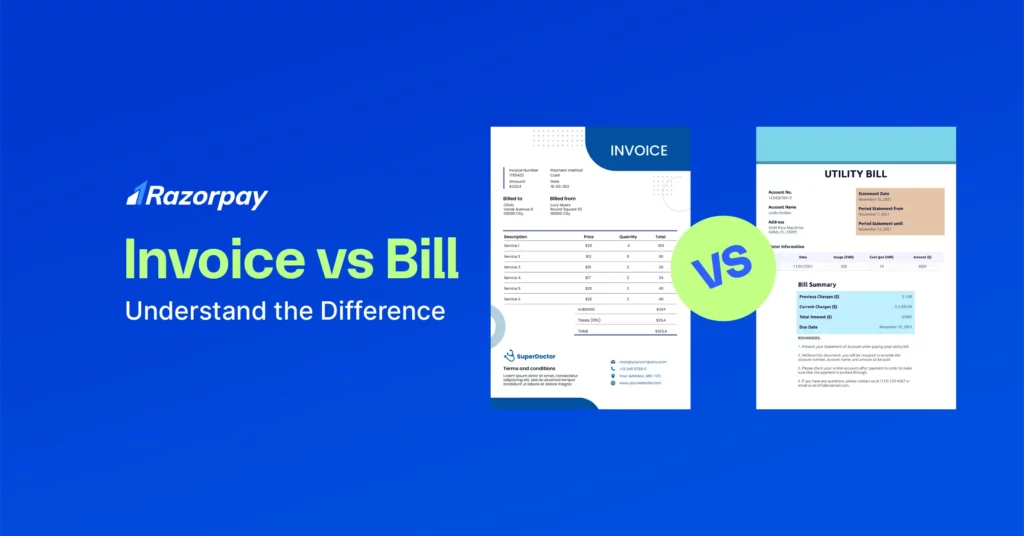An invoice is a detailed document issued by a seller to a buyer, listing the products or services provided and the amount due. On the other hand, a bill is typically received by the buyer, indicating the amount owed for goods or services rendered.
Knowing the difference between an invoice and a bill helps business owners and financial professionals streamline their accounting processes and avoid confusion.
Related Read: Automate Your Invoice with Razorpay
Table of Contents
What is the Difference Between Invoice and Bill?
Sellers send invoices to request payment for goods or services from buyers, while vendors or suppliers issue bills to request payment for products or services.
Aspect |
Invoice |
Bill |
|
Purpose |
Request for payment |
Statement of the amount due |
|
Issuer |
Seller or service provider |
Seller, service provider, or utility company |
|
Recipient |
Buyer or client |
Customer or consumer |
|
Payment terms |
Often includes due dates and terms |
Usually requires immediate payment |
|
Detail level |
Typically more detailed |
Can be less detailed |
|
Legal status |
Often has legal standing |
May have less legal weight |
|
Use in accounting |
Used for accounts receivable |
Used for accounts payable |
|
Customisation |
Often customised with company branding |
Usually standardised format |
Related Read: Accept Payments with Razorpay Payment Links and Buttons
What is an Invoice?
An invoice is a commercial document issued by a seller to a buyer that itemises and records a transaction between the two parties.
It is typically sent by a business to its clients after goods have been delivered or services have been performed, but before payment is made.
Invoices serve as a formal request for payment and provide a detailed breakdown of the products or services provided, along with the total amount due and payment terms.
What are the Types of Invoices?
There are several types of invoices used in various business scenarios:
-
- Standard Invoice: The most common type, detailing goods or services provided and the amount due.
- Recurring Invoice: Used for repeated billing cycles, such as monthly subscriptions or retainer fees.
- Commercial Invoice: Used in international trade to declare the value of goods for customs purposes.
- Proforma Invoice: A preliminary bill of sale sent to buyers before the delivery of goods or services.
- Credit Invoice: Issued to correct a mistake or provide a refund on a previous invoice.
- Debit Invoice: Used to increase the amount of a previous invoice due to changes or additional charges.
- Interim Invoice: Used for long-term projects to bill for completed portions of work.
- Final Invoice: Sent at the completion of a project, summarising all charges and payments.
Related Read: Invoice Vs Proforma Invoice: Differences, Benefits and Examples
What are the Uses of an Invoice?
Invoices serve multiple important purposes in business operations:
1. Maintaining Records
Invoices provide a detailed account of sales transactions, helping you track your income and manage financial records accurately.
2. Payment Tracking
They allow you to monitor outstanding payments and follow up on overdue accounts, ensuring a steady cash flow.
3. Legal Protection
Invoices serve as legal documents that can be used as evidence in case of payment disputes or audits.
4. Easy Tax Filing
By keeping a record of all sales, invoices simplify the process of calculating and reporting taxes.
5. Business Analytics
Analysing invoice data can provide insights into sales trends, customer behaviour, and overall business performance.
6. Professional Image
Well-designed invoices contribute to a company’s professional image and brand identity.
7. Customer Communication
Invoices can be used to convey important information such as payment terms, upcoming promotions, or changes in business policies.
What is a Bill?
A bill is a statement of charges for goods or services that have already been provided. It is typically created by the seller or service provider and given to the customer or consumer after the transaction has taken place.
Bills are often associated with regular expenses such as utilities, rent, or subscription services, and they usually request immediate or prompt payment for the amount due.
What are the Types of Bills?
Various types of bills are common in everyday life and business operations:
-
- Utility Bills: Charges for services like electricity, water, and gas.
- Rent Bills: Monthly statements for property rental payments.
- Subscription Bills: Regular charges for ongoing services like streaming platforms or software.
- Credit Card Bills: Monthly statements of credit card usage and payments due.
- Purchase Bills: Receipts for goods bought, often used in retail transactions.
- Medical Bills: Statements of charges for healthcare services and treatments.
- Phone Bills: Monthly charges for mobile or landline phone services.
- Internet Bills: Regular charges for internet service provision.
- Tax Bills: Government-issued statements for property taxes or other levies.
- Service Bills: Charges for professional services like legal or consulting work.
- Insurance Bills: Regular premiums for various types of insurance coverage.
- Education Bills: Tuition and fee statements from educational institutions.
Related Read: Difference Between an Invoice and Receipt
What are the Uses of a Bill?
Bills are essential documents in financial transactions, serving as a record of goods or services purchased, the amount owed, and the agreed-upon payment terms.
Bills have several important uses:
- Record of Purchases: Bills provide a detailed account of goods or services bought, helping in expense tracking and budgeting.
- Reminder for Payment: They serve as a prompt for customers to make timely payments for services or products received.
- Financial Reporting: Bills are used in accounting to accurately record expenses and liabilities.
- Streamlining Billing: Regular billing helps businesses maintain a steady cash flow and manage their finances effectively.
- Bill Pay: Many financial institutions offer bill pay services, allowing customers to automate payments based on received bills.
- Expense Verification: Bills allow customers to verify charges and dispute any discrepancies if necessary.
Conclusion
Understanding the difference between invoice and bill is crucial for effective financial management and smooth business operations. Invoices request payment for goods or services provided, while bills summarise charges incurred and request immediate payment.
FAQs
1. What is an example of a bill and invoice?
An example of a bill is a monthly utility statement for electricity usage. An example of an invoice is a detailed document sent by a freelance graphic designer to a client after completing a project, requesting payment for services rendered.
2. Is an invoice also known as a bill?
While often used interchangeably, invoices and bills are not exactly the same. An invoice is typically more detailed and is sent before payment, while a bill is usually simpler and presented after goods or services have been received.
3. What is the difference between a waybill and an invoice?
A waybill is a document used in shipping that lists the goods being transported and their destination. An invoice is a financial document requesting payment for goods or services provided.
4. What is the difference between a bill and a purchase invoice?
A bill is typically a simpler document presented after a purchase, while a purchase invoice is a more detailed document issued by the seller to the buyer, often before or at the time of purchase.
5. When to use an invoice vs. a bill?
Use an invoice when you’re requesting payment for goods or services provided, typically before payment is made. Use a bill when presenting charges for goods or services already received or consumed by the customer.
6. What information does an invoice typically include that a bill might not?
An invoice often includes more detailed information such as itemised descriptions of goods or services, payment terms, due dates, and sometimes tax calculations. Bills may be simpler, focusing mainly on the total amount due.
7. How quickly does payment need to be made for an invoice vs. a bill?
Invoice payments usually follow the terms specified on the document, which can range from immediate payment to 180 days. Bills often require more immediate payment, especially for regular expenses like utilities or rent.


